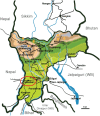Prevalence, risk factors and treatment-seeking behaviour for malaria: the results of a case study from the Terai region of West Bengal, India
- PMID: 21801498
- PMCID: PMC4090793
- DOI: 10.1179/136485911X12987676649548
Prevalence, risk factors and treatment-seeking behaviour for malaria: the results of a case study from the Terai region of West Bengal, India
Abstract
India is among the countries that are worse affected by human malaria, one of the major vector-borne diseases that continue to affect vast populations across the world. In a recent household survey in the Terai region of eastern India, the factors that might explain the occurrence and clustering of human malaria and the consequent healthcare-seeking behaviour of the human population were explored. The topography and geo-climatic conditions in Terai appear to intensify the risks of malaria but some socio-economic attributes, such as engagement in agricultural occupations, poor economic status and congested household environments, were also identified as significant risk factors for the disease. In the study area, public health facilities predominate as sources of medical care for malaria, although, at least in the early stages of treatment seeking, informal providers and pharmacies are also often involved. Unfortunately, despite the high frequency of malarial outbreaks, the local public health facilities were found to be ill-equipped to tackle and contain the spread of malaria. Preventive public-health measures, health education on malaria and malaria-awareness exercises were found to be scarce and irregular. The reliance on a reactive strategy of offering curative care to the affected led to overcrowding in healthcare facilities and shortages of medicines and diagnostic procedures. Along with a more efficient and reliable emergency system to deal with major outbreaks of malaria, more effective convergent interventions, by the local government and other stakeholders, should be developed to help prevent the disease.
Figures





Similar articles
-
Malaria Related Perceptions, Care Seeking after Onset of Fever and Anti-Malarial Drug Use in Malaria Endemic Settings of Southwest Ethiopia.PLoS One. 2016 Aug 12;11(8):e0160234. doi: 10.1371/journal.pone.0160234. eCollection 2016. PLoS One. 2016. PMID: 27517717 Free PMC article.
-
Care-seeking behaviour and treatment practices for malaria in children under 5 years in Mozambique: a secondary analysis of 2011 DHS and 2015 IMASIDA datasets.Malar J. 2019 Apr 2;18(1):115. doi: 10.1186/s12936-019-2751-9. Malar J. 2019. PMID: 30940127 Free PMC article.
-
Determinants of prompt and adequate care among presumed malaria cases in a community in eastern Rwanda: a cross sectional study.Malar J. 2016 Apr 21;15:227. doi: 10.1186/s12936-016-1285-7. Malar J. 2016. PMID: 27098976 Free PMC article.
-
El Niño and associated outbreaks of severe malaria in highland populations in Irian Jaya, Indonesia: a review and epidemiological perspective.Southeast Asian J Trop Med Public Health. 1999 Dec;30(4):608-19. Southeast Asian J Trop Med Public Health. 1999. PMID: 10928348 Review.
-
Health status of tribes of Uttar Pradesh with special reference to health-seeking behaviour of uncharted Tharu tribe: A mapping review.Indian J Med Res. 2022 Aug;156(2):186-190. doi: 10.4103/ijmr.ijmr_3271_21. Indian J Med Res. 2022. PMID: 36629178 Free PMC article. Review.
Cited by
-
Elimination therapy for the endemic malarias.Curr Infect Dis Rep. 2012 Jun;14(3):227-37. doi: 10.1007/s11908-012-0250-z. Curr Infect Dis Rep. 2012. PMID: 22415581 Free PMC article.
-
Prevalence of Pregnancy Associated Malaria in India.Front Glob Womens Health. 2022 May 26;3:832880. doi: 10.3389/fgwh.2022.832880. eCollection 2022. Front Glob Womens Health. 2022. PMID: 35692947 Free PMC article.
-
Awareness of malaria and treatment-seeking behaviour among persons with acute undifferentiated fever in the endemic regions of Myanmar.Trop Med Health. 2017 Dec 4;45:31. doi: 10.1186/s41182-017-0070-9. eCollection 2017. Trop Med Health. 2017. PMID: 29213208 Free PMC article.
-
Malaria Risk Map Using Spatial Multi-Criteria Decision Analysis along Yunnan Border During the Pre-elimination Period.Am J Trop Med Hyg. 2020 Aug;103(2):793-809. doi: 10.4269/ajtmh.19-0854. Epub 2020 Jun 25. Am J Trop Med Hyg. 2020. PMID: 32602435 Free PMC article.
-
Chemotherapeutics challenges in developing effective treatments for the endemic malarias.Int J Parasitol Drugs Drug Resist. 2012 Feb 17;2:256-61. doi: 10.1016/j.ijpddr.2012.01.004. eCollection 2012 Dec. Int J Parasitol Drugs Drug Resist. 2012. PMID: 24533286 Free PMC article.
References
-
- Anon(2007)Health on the March, 2006–07 Kolkata, India: Department of Health and Family Welfare
-
- Baruah I, Das NG, Kalita J.(2007)Seasonal prevalence of malaria vectors in Sonitpur district of Assam, India. Journal of Vector Borne Diseases 44149–153. - PubMed
-
- Das NG, Talukdara PK, Kalita J, Baruah I, Srivastava RB.(2007)Malaria situation in forest-fringed villages of Sonitpur district (Assam), India bordering Arunachal Pradesh during an outbreak. Journal of Vector Borne Diseases 44213–218. - PubMed
-
- Dev V, Dash AP, Khound K.(2006)High-risk areas of malaria and prioritizing interventions in Assam. Current Science 9032–36.
MeSH terms
Substances
LinkOut - more resources
Full Text Sources
Medical
